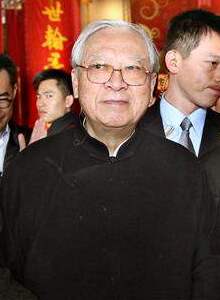Au Ho-nien


| Au Ho-nien | |||||||||||
|---|---|---|---|---|---|---|---|---|---|---|---|
| Traditional Chinese | 歐豪年 | ||||||||||
| Simplified Chinese | 欧豪年 | ||||||||||
| |||||||||||
Au Ho-nien (Chinese: 歐豪年; 1935 – 25 April 2024) was a Chinese painter. He studied under Chao Shao-an and his ink wash paintings, representative of the Lingnan School,[2]: 140, 151 were influential in Taiwan. His subject matter included landscapes, animals, feathers, and other elements, and his art used rich, varied forms alongside strong and vivid colors.[3][4][5] In 2019, a solo exhibition of his work was displayed at the Asian Art Museum in San Francisco.[6]
Early life
Au Ho-nien was born in Maoming, Guangdong, in 1935. He studied under Chao Shao-an from 1952, at age 17, and belonged to the Lingnan School.[7] In 1950, his family moved to Hong Kong.[2]
Art and teaching career
In 1968, Au held his first solo exhibition at the National Museum of History in Taiwan.[2]: 52 In the same year, President Chiang Kai-shek and his wife Soong Mei-ling selected eight of Au's pieces for the collection in the Zhongshan Building in Taipei,[2]: 57 where they have remained on display for decades. In 1970, when he was 35 years old, Au went to Taiwan to teach at the Chinese Culture University,[8] settling on the island and creating close ties between the Lingnan School of painting and the development history of art education in Taiwan.[2]: 59 Beginning several years after settling in Taiwan, Au helped spread Chinese culture worldwide through his participation in international exhibitions.[2]: 76 As Taiwan's political situation on the international stage became difficult, Au participated in international art exhibitions as a means of cultural diplomacy,[2]: 88 and was a representative of Taiwanese artists during Taiwan's economic boom.[2]: 97
In 1983, Au served as a jury member for the National Literature and Art Awards.[2]: 157 In 1993, he was bestowed with a Special Award of the Grand Palais in Paris, France, becoming the first Chinese painter to win this honor.[9][10] In 1994, he was awarded an honorary doctorate by Wonkwang University in South Korea. In 1995, he was hired as a director of the Chu Hai College of Higher Education in Hong Kong. In 1999, he won the second Global Outstanding Persons Gold Dragon Award.[11] In June 2016, he was awarded an honorary Doctor of Letters degree from National Dong Hwa University, and in November of the same year, he was also awarded an honorary doctor of letters degree from the Chinese University of Hong Kong.[12]
In 2000, he established the Au Ho-nien Cultural Foundation,[2]: 131 organizing large-scale exhibitions and academic seminars on the Lingnan School.[2]: 110
In 2002, the Au Ho-nien Cultural Foundation donated more than 100 paintings to Academia Sinica to establish the Lingnan Fine Arts Museum.[13] In 2004, the University of Indianapolis established the Au Ho-nien Museum, and in 2005, the Au Ho-nien Art Center (now the Au Ho-nien Art Museum) was established on Chinese Culture University's Yangmingshan Campus in Taipei.[2]: 83
Later years
In his later years, he devoted himself to poetry, publishing "A Poem of Yicui Mountain Hall" in 2006. Qin Xiaoyi praised him as a "great master" and all-rounder of poetry, calligraphy, and painting unique in the history of the Lingnan School.[2]: 138–139
Au's work is characterized by the Lingnan School's use of colors, white space, and skeletal structure, along with a combination of modern and Western elements. In his later years, he integrated poetry and calligraphy into his paintings, earning him a reputation as an artist embodying the humanistic spirit of Eastern cultural tradition.[14][15][16] Painter Chu Ko described Au's paintings as having "achieved the realm of one whose 'mastery has penetrated downward', which is why he enjoys a great reputation".[2]: 70
Au died on 25 April 2024, at the age of 89.[17]
References
- ^ "Heritage Museum holds large-scale exhibition for master of Lingnan school of painting Au Ho-nien (with photos)". www.info.gov.hk. Archived from the original on 1 September 2019. Retrieved 27 April 2024.
- ^ a b c d e f g h i j k l m n 《豪邁‧幽遠‧歐豪年》. Taiwan Museum of Fine Arts. 2013. ISBN 9789860381580.
- ^ "欧豪年:还携笔墨向高丘". 人民網. 12 March 2018. Archived from the original on 26 April 2024. Retrieved 19 December 2022.
- ^ "Asian Art Museum | The Bold Brush". www.asianart.org. Archived from the original on 23 June 2019. Retrieved 23 June 2019.
- ^ Ou, Haonian (2004). Journey with art afar : the Au Ho-nien Museum, University of Indianapolis. Lan, Caifeng, University of Indianapolis. Au Ho-nien Museum. Indianapolis, IN: University of Indianapolis Press. ISBN 0880938587. OCLC 68927186. Archived from the original on 26 April 2024. Retrieved 23 June 2019.
- ^ "The Bold Brush of Au Ho-nien". Asian Art Newspaper. 29 April 2019. Archived from the original on 23 June 2019. Retrieved 23 June 2019.
- ^ 王儒哲 (26 September 2014). "豪氣萬千歐豪年80水墨特展" (in Chinese (Taiwan)). 《中國時報》. Archived from the original on 26 May 2020. Retrieved 14 August 2018.
- ^ ""鹏翼展天宽——欧豪年书画展"在中国国家博物馆开幕". 30 September 2013. Archived from the original on 26 April 2024. Retrieved 19 December 2022.
- ^ "台湾著名画家欧豪年:曾获巴黎大宫博物馆特别奖". 19 January 2015. Archived from the original on 19 December 2022. Retrieved 19 December 2022.
- ^ "歐豪年教授獲頒東華大學名譽文學博士學位". 國立東華大學. Archived from the original on 19 August 2018. Retrieved 19 August 2018.
- ^ 歐豪年近十年創作集. pp. 82–83.
- ^ "香港中文大学颁授荣誉博士学位予三位杰出人士". 香港中文大学传讯及公共关系处. Archived from the original on 7 June 2019. Retrieved 16 August 2018.
- ^ 李遠哲 (11 May 2002), "本館簡介─成立緣由", 嶺南美術館, 中央研究院, archived from the original on 17 April 2021, retrieved 8 January 2021
- ^ "百科知識/歐豪年". jendow.com.tw. Archived from the original on 18 March 2023. Retrieved 21 December 2022.
- ^ "中誠拍賣/歐豪年". art106.com. Archived from the original on 21 December 2022. Retrieved 21 December 2022.
- ^ "臺灣美術拼圖順天收藏/順天畫家歐豪年". National Taiwan Museum of Fine Arts. Archived from the original on 27 January 2023. Retrieved 23 March 2023.
- ^ "嶺南畫派宗師歐豪年辭世 文化部表達哀悼與敬意". Ministry of Culture, Republic of China. 26 April 2024. Archived from the original on 26 April 2024. Retrieved 26 April 2024.
